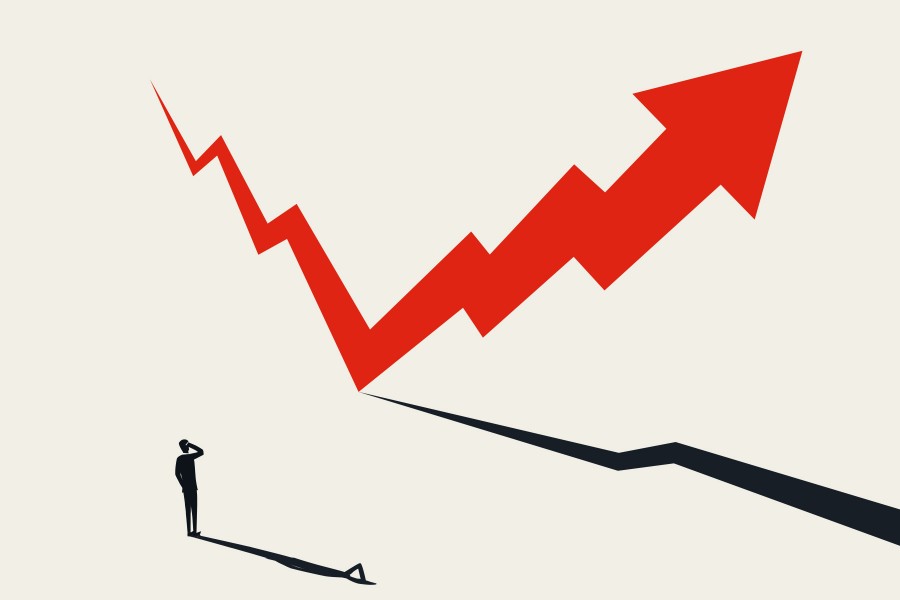The pandemic is not over. It is still taking its toll on human lives and the economy. In some countries, the deadly pathogen remains highly active. It is infecting more than a hundred thousand people and claiming between 800 and 1000 lives a day in each of these countries.
However, in some countries, particularly in Asia and Africa, the virus is less virulent, at least, for now, thus, offering a scope to pick up life anew.
Bangladesh is lucky to be one of those. A second wave of the disease in the coming winter is feared. Yet normalcy has returned to a large extent in the people's lives.
As far as the start of the economic activities is concerned, there exists a mixed trend. Since the lifting of the restrictions in early May, the economic activities have gathered pace, but far short of the normal level. The pace of picking up business activities in some areas of the economy is faster than many others, depending on the demand for goods and services.
The results of a recent survey carried out jointly by the South Asian Network for Economic Modelling (SANEM) and the Asia Foundation (AF) might help in assessing the situation concerning the state of economic recovery during the 'post-holiday' phase. The survey conducted in two phases in July and October covered 805 large, medium, small and micro enterprises in the manufacturing and services sectors.
Though the survey has covered a small number of enterprises, it is representative in nature. It finds the strong recovery of all types of enterprises in the 'post-Covid' period to be very limited, around 4.0 per cent of the enterprises surveyed. However, there are reasons to be optimistic as around 41 per cent of the enterprises reported modest recovery. Here, large enterprises have done better. Nearly 54 per cent of them have achieved a modest recovery.
The situation with the small and micro enterprises, however, is a bit frustrating. According to the SANEM-AF survey, 33 per cent of them have failed to record any sort of recovery and another 31 per cent have made a weak recovery. Half of the medium-scale enterprises have recorded strong to moderate recovery since the resumption of economic activities.
There is no denying that the pandemic is still there. The infection rate is still between 12 per cent and 13 per cent and some people are dying of the disease daily. So, there exists a sort of uneasiness everywhere. Everybody is eagerly waiting for an effective vaccine to arrive.
Health reasons aside, the financial loss remains a key factor that has hurt businesses, small or big, most. Most of them are finding it difficult to recoup the losses that the pandemic has caused. Naturally, the large enterprises have greater ability to cope with an adverse situation, compared with the micro, small and medium enterprises (MSMEs).
Thousands of small and micro enterprises, in particular, failing to withstand the onslaught of the pandemic, have gone out of business. The possibility of their making a return appears remote. Many others are also waiting to follow suit.
In such a situation, the availability of financial support for all types of enterprises is of utmost importance. The government has been prompt in offering that. During April and May, the government put in place stimulus packages worth over one trillion taka. The loan packages meant for various sectors of the economy and micro-level professionals and farmers carry reduced interest rates.
However, the disbursement of loans under various packages has not been even. Some sectors got more, some others less. In this case, MSMEs are the most affected. Most of the stimulus package for large enterprises is exhausted. The export-oriented apparel units have got more than what was originally allocated. On receipt of the request from the industry leaders, the government increased its original package by Tk 30 billion to Tk 80 billion to pay the wages of the RMG workers. Recently, the RMG industry has sought a few more concessions in the matters of bank loan repayment.
Disbursement of loans under the stimulus package by banks among the MSMEs is rather dismal. The rate of disbursement until September last was less than one-third of the fund earmarked for them. The policymakers have asked the banks to beef up the disbursement, but there are certain bottlenecks.
Traditionally, the banks are not particularly enthusiastic about lending to micro and small businesses. The offering of collateral against loans is a problem, no doubt. What, however, is a major barrier, in this case, is the attitude of the banks. In such a situation, the MSMEs do usually borrow from cooperatives and other informal sources that charge cutthroat rates of interest. Unless and until banks change their attitude to small and micro borrowers, the situation is expected to remain so.
Against this backdrop, there has been a suggestion to offer a new loan package to the MSMEs. Given the huge number of affected MSMEs, such a proposal does deserve proper scrutiny. At the same time, the policymakers should ensure that banks make an aggressive approach towards disbursement of the existing loan package for MSMEs, distressed professionals and farmers.


